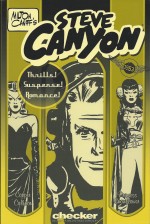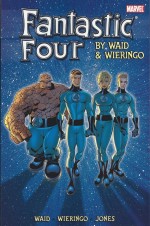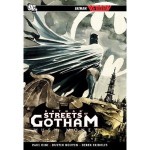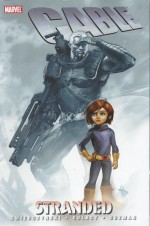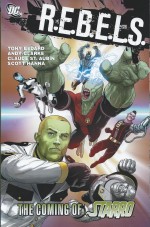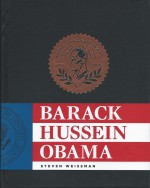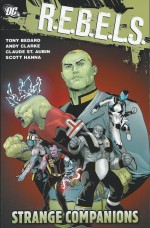
By Tony Bedard, Andy Clarke, Claude St. Aubin, Karl Moline, Derec Donovan, Kalman Andrasofszky & various (DC Comics)
ISBN: 987-1-4012-2761-6
Once upon a time, DC’s vast pantheon of characters was sensibly scattered, segregated and wholly distinct: separated and situated on a variety of alternate Earths which comprised Golden Age hold-overs, contemporaneous Silver Age stars and later-created heroes. Further Earths were subsequently introduced for every superhero stable the company scooped up in a voracious and protracted campaign of acquisition over the decades. Charlton, Fawcett, Quality Comics and others’ characters resided upon their own globes, occasionally meeting in trans-dimensional alliances and apparently deterring new readers from getting on with DC.
Latterly, when DC retconned their entire ponderous continuity following Crisis on Infinite Earths in 1985-1986, ejecting the entire concept of a multiverse and re-knitting time so that there had only been one world literally festooned with heroes and villains, many of their greatest characters got a unique restart, with the conceit being that the characters had been around for years and the readership were simply tuning in on just another working day.
Of course now the multiverse concept is back and not confusing at all (no! seriously?) but whatever the original reasons, that dramatic 1980s refit did provide for some utterly astounding and cleverly cohesive stories…
In the aftermath of that event, the hero-packed planet Earth was targeted by a coalition of alien races and endured a full-on Invasion which was repulsed by the indomitable resistance of the World’s assembled heroes and villains and a few selected extraterrestrial allies. When the cosmic dust settled a few of these stayed together and formed cops-for-profit outfit dubbed L.E.G.I.O.N., led by a lying, scheming, manipulative obsessive super-genius bastard named Vril Dox: notional son of the villainous super-villain Brainiac of Colu and one of the most superciliously smug creatures in creation.
Overcoming all odds and the general distaste of his own chief lieutenants, Dox moulded his organisation into a force for justice and peace in the universe, with over 80 client worlds happily prospering, until his own son Lyrl – whilst still a baby – usurped control of the organisation: hunting Vril and his core agent team across the universe as desperate R.E.B.E.L.S. ruthlessly pursued by their own intergalactic commercial police force.
By the end of that run of comicbooks in 1996, order and the status quo were fully restored and the Licensed Extra-Governmental Interstellar Operatives Network went back to scrupulously and competently doling out all the peace and security solvent worlds could afford…
In the first volume, Dox’s organisation was snatched from his implacable grasp by an alien incursion from another galaxy, led by a terrifying mystery despot who had apparently subjugated the predatory Starros and turned their mind-sucking, power-leeching abilities to the creation of an unbelievably vast inter-galactic empire, policed by an unstoppable host of super-slaves and subservient legions.
Acting upon information received from his own descendent in the 31st century, Dox began assembling a super-powered strike force from across known space: old allies and pawns, new heroes – and even villains and monsters. Whoever he couldn’t coerce or co-opt Dox created, such as with the crippled Anasazi girl he transformed into a ball of sentient space-spanning energy he dubbed Wildstar…
However, just as he was compiling his arsenal of living weapons and preparing to take back control of L.E.G.I.O.N., events overtook him again. From far outside our galaxy an impossible army of invaders burst through a space rift, all enslaved by and connected to a telepathic starfish creature named Starro, yet somehow controlled by a humanoid master who had learned how to psychically dominate the universally-feared pentagram predators…
Within hours the Armada had destroyed the impregnable homeworld of the dreaded Dominators and were preparing to spread across the Milky Way, until Dox, with typical reckless brilliance, locked the entire quadrant within an impenetrable forcefield stalling the invasion by trapping hundreds of worlds – and his ragtag R.E.B.E.L.S. unit with them – in an inescapable cage with the most rapacious creatures in creation…
Collecting issues #7-9 of the revived comicbook series and the first R.E.B.E.L.S. Annual: Starro the Conqueror (all from 2009), the drama is scripted as ever by Tony Bedard and continues with ‘No Way Out’ (illustrated by Andy Clarke) wherein the only Dominator to escape the fall of his own species’ ancient empire goes hunting for allies and revenge. Dox too is seeking outside help – with as little success – from planetary dictators such as Despero or Kanjar Ro and extremist regimes such as the bellicose Khunds: all elements he used to be paid good money to keep away from decent sentients and his client worlds…
The aquatic, methane breathing mega-teleporters of Gil’Dishpan at least agreed to a meeting with both Dox and the Dominator, keenly aware that their inherent space-shifting capabilities presented Starro’s forces with an irresistible opportunity to break out of the vast but impenetrable force cage frustrating their outward expansion…
The venal Gil’Dishpan had actually planned to give their diplomatic guests to Starro in return for a neutrality pact but the invaders instead attacked the methane-dwellers, ultimately forcing Dox and the last Dominator to make absolutely sure no teleporters remained for the starfish to mind-control…
In ‘Stealth’ (Clarke art again) the ragtag band of resistors track down the banished and now teenaged Lyrl Dox, press-ganging the former tiny tyrant into the fight just as Starro’s metahuman brigade turned their unstoppable attentions upon the Khundish empire – with the now inevitable result of total submission through horrendous bloodshed.
On another front the insidious Psions contrived a ghastly biological cloaking mechanism and despatched the far-from happy Omega Men through the still-open space rift to the Horde’s mysterious point of origin…
The titular ‘Strange Companions’ – lavishly rendered by Claude St. Aubin & Scott Hanna – pulls more threads into the swiftly expanding cosmic tapestry as Wildstar goes in search of other allies trapped within the contained quadrant whilst the Omega Men discover disquieting, unsuspected secrets on the other side of the sky.
As Starro lieutenant Smite personally crushes all resistance on Kanjar Ro’s fortress world Dhor, the dictator is rescued at the last moment by his archenemy Adam Strange, another recruit to Dox’s resistance movement as is Earthling mutant superman Captain Comet.
The assembled rebels don’t have long to catch their breath however as the frustrated Smite arrives in blockbusting manner leading a squad of Starro super-soldiers and tasked with capturing – or is that liberating? – Lyrl Dox: a lad who’s been correctly assessed as even smarter and more ruthless than the father he’s always hated…
To Be Continued…
The rest of this volume reprints the Annual; offering a quintet of tales uncovering secrets and disclosing hidden facts about the unbeatable enemy forces. The eponymous framing sequence ‘Starro the Conqueror’ (illustrated by St. Aubin & Hanna) connects five powerfully revelatory chapters beginning with ‘The Doom that Came to Kalanor’ as the supreme master of the invaders personally destroys the diabolical Despero – a brutal juggernaut who has killed billions in his day. That day, though, is soon done…
The action continues by revealing the backgrounds of the pitiless, uncompromising invaders beginning with the tragic ‘Daughter of Storms’ (with art from Karl Moline & Mark Pennington): life-giving goddess of a world who lost everything when the starfish landed in her skies…
This is followed by an introduction to the worst Starro can offer as St. Aubin & Hanna convene ‘The High Vanguard’: brutal monsters who serve the as the semi-autonomous elite of the rapacious Horde, after which Derec Donovan delineates the story of Smite who was ‘Scourge of the Stars’ even before falling to the unrelenting overlord of infinity…
This volume concludes with the horrific origin of ‘The Star Conqueror’ (art by Kalman Andrasofszky) which shows how a gentle holy man defeated an intolerable invading interplanetary predator and unwittingly unleashed a far greater menace upon all of creation…
With a spectacular cover gallery by Andy Clark & Andrasofszky, this slim tome offers a deliciously intoxicating blend of space opera and cosmic action that will push every button for lovers of staggering science fiction thrills, cut with sharp, mature dialogue and sublimely beautiful artwork. More straight and simple, mind-boggling, slyly cynical, riotous rollercoaster fun no fan of fantasy should do without…
© 2009, 2010 DC Comics. All Rights Reserved.

